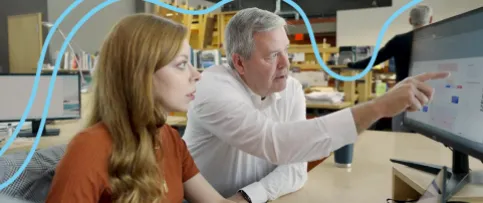Based in Pennsylvania, Project Architect Parva Markiw gives us a run-down of her daily life as an architect and the importance of representation architecture. As an English as a Second Language (ESL) speaker, Parva shares the obstacles she faced while accomplishing her requirements for licensure. She also gives top tips and resources for candidates with similar experiences to help you stay on top of your goals!
What motivated you to pursue a career in architecture?
I was introduced to architecture by a family friend when I was very young, and I immediately fell in love with the idea of being an architect. I knew I needed to become an architect. I was so fascinated with architecture that I drew floor plans for every home we visited.
You currently work as a project architect at DesignGroup. Can you tell us what a typical day looks like for you?
I work on several projects with varying complexity and size, from a neuroscience clinic to university student unions. My tasks change from day to day depending on the type of project and stage of design the project is in.
For projects in the design development and construction documentation phases, I model and develop details in Revit, progressing the drawings toward the next deliverable. While producing drawings, I come up with questions to bring up at the next client meeting. I lead these client meetings by providing project updates on design, asking the list of clarifying questions, and requesting feedback from the client. I have several projects that are in the construction phase, and I spend several hours a week going to the construction site to observe the progress and answer any field questions from contractors.
What was your journey to licensure like? How did you navigate the process as an English as a Second Language (ESL) candidate?
My journey had a lot of ups and downs—mostly downs. I started taking the exams on my own in February of 2016, and right off the bat, I had two fails, which wasn’t the start I had been hoping for. It had a huge negative impact on my self-esteem and trust in myself. I passed the next exam, then had another two failed exams, which made me second guess my study strategy. I decided I could benefit from a local or regional Architect Registration Examination® (ARE®) study group. I started to look for a study group and came across Michael Riscica’s Young Architect Bootcamp.
The program was just what I needed; it connected me with many resources, peers who were also studying, and ESL candidates. This was especially helpful because everyone’s strengths are different, and it allowed us to learn from each other. As someone who does not speak English as their first language, understanding what questions were asking me was a big struggle for me.
I learned through the study group how to digest and understand the information given in the questions, how to trust myself, and that I should listen to my gut.
Every time I showed up for an exam, I was adequately prepared; I had spent countless hours studying and learning a ton of information. From beginning to end, it took me four years to pass all the exams, including 14 fails. When I look back on the journey, it doesn’t matter how many exams I failed; only the ones I passed made me an architect.
As a member of Women+ in Design PGH—why is representation in architecture so important to you?
As diverse as my college was, I was surprised to see and feel the absence of minorities in the architecture program over a decade ago. I was one of the few people of color, and it gave me little hope of entering a diverse workplace after graduation. As a gay female immigrant and first-generation college graduate, I knew I had to pave my own path in this industry. That meant blending in as much as I could.
In my first job, I avoided calling any attention to the differences that set me apart from my white counterparts. On paper, it felt important to convey my background, but when it came to interviews and work, I instead tried to put people at ease by stifling the things that made me unique. I knew I needed to grow my network during my early years in Pittsburgh, so I searched for events and made a conscious effort to connect with diverse professionals. Women+ in Design is committed to welcoming and empowering individuals of all genders working in design or design-adjacent fields. The organization acknowledges the importance of banding together with other groups who have not been in positions of power and hopes to bolster the diversity of our industry.
Now, as a licensed architect, what are your hopes for the future of the profession?
My hope for the future of our industry is an increased public awareness of the importance of an architect’s role. Becoming an architect takes many years of schooling, time, hard work, dedication, and money. It’s important for us to advocate our value as leading professionals.
What advice or resources would you recommend to someone still on their journey to licensure?
I suggest everyone consider the resources or programs their local or state AIA chapter may offer. These can be monetary grants, study sessions with fellow candidates, or study materials available to use. I have been the chair of the AIA Pennsylvania Emerging Professional Committee for the past four years, and we offer a grant to eligible emerging professionals to provide financial assistance for the ARE. The Paula Maynes AIA Pennsylvania Grant reimburses candidates upon receipt of a passed ARE division. My other advice is to just jump in and get started. The very first step is to sign up for an exam and start studying! As you study, take the time to dig deep and go beyond what the test is asking for to become a subject matter expert. This will serve you well later in your career.
For more resources, advice, and experiences from your peers and architects making strides in the field, check out our Instagram, YouTube channel, TikTok, Facebook, and blog to find what you need to keep your journey going.



